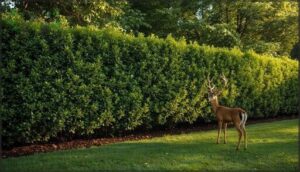This site is supported by our readers. We may earn a commission, at no cost to you, if you purchase through links.
White-tailed deer consume roughly 15 pounds of vegetation daily, and your carefully tended garden represents an all-you-can-eat buffet they’ll visit repeatedly once discovered. These adaptable browsers don’t respect property lines or seasonal boundaries, making year-round protection essential for anyone growing ornamentals, vegetables, or fruit trees in deer territory.
The good news: you don’t need harsh chemicals or expensive electric systems to protect your landscape. Physical barriers like properly installed fencing, strategic plantings of species deer naturally avoid, and natural repellents that exploit their sensitive noses create effective defense zones around your property.
When you combine multiple deterrent methods and understand deer behavior patterns, you can maintain a thriving garden even in areas with high deer populations.
Table Of Contents
- Key Takeaways
- Effective Physical Barriers to Deter Deer
- Natural Repellents and DIY Deterrent Methods
- Planting Deer-Resistant and Repellent Plants
- Top 5 Products to Keep Deer Away
- Frequently Asked Questions (FAQs)
- What is the most effective natural deer repellent?
- How do I keep deer out of my yard at night?
- What smells do deer hate the most?
- Do coffee grounds keep deer away?
- Does Irish Spring soap really deter deer?
- What is the best homemade deer repellent?
- What smell do deer hate the most?
- Do deer eat roses?
- How high should my deer fence be?
- What scents do deer hate most?
- Conclusion
Key Takeaways
- Physical barriers like 7-8 foot fencing remain the most reliable defense with up to 90% effectiveness, though combining multiple deterrent methods—fencing, repellent plants, and scent-based deterrents—creates the strongest protection against deer browsing.
- Homemade egg-based sprays reduce deer browse by up to 90% at just $2-5 per acre, but all repellents require rotation every 6-8 weeks to prevent habituation since deer adapt quickly to consistent scents or tastes.
- Strategic planting of deer-resistant species like boxwood, aromatic herbs, and thorny barriers creates natural defense zones, with regionally adapted native plants experiencing up to 56% less browsing damage than non-native varieties.
- Scent-based deterrents like soap, human hair, and predator urine show modest effectiveness (15-50% browse reduction) and require frequent reapplication, making them best suited as supplements to physical barriers rather than standalone solutions.
Effective Physical Barriers to Deter Deer
Physical barriers remain your most reliable defense against persistent deer visitors. When deer can’t access your plants, they’ll move on to easier feeding grounds.
Let’s look at the most effective barrier methods you can use to protect your yard and garden.
Installing Deer-Proof Fencing
When installing deer fences, aim for a height of 7 to 8 feet, as deer struggle to clear taller barriers. Material selection matters—woven-wire and wire mesh offer durability, while chain-link provides permanence at higher installation costs.
Expect to invest $1,400 to $7,000, depending on perimeter length and materials. Professional installation can help with compliance with codes, adding to the fence’s durability. Maintenance needs include vegetation control and occasional repairs.
While these physical barriers deliver up to 90% effectiveness, their visual impact on your property deserves consideration.
Using Plastic Netting and Row Covers
For those seeking more affordable physical barriers, plastic netting and floating row covers provide effective protection for your vegetable garden. These options reduce deer damage while keeping installation costs manageable—often under $2 per linear foot.
Coverage strategies that work:
- Install netting at least 7.5 to 8 feet high
- Space support posts every 3 to 4.5 yards
- Stake edges firmly to prevent crawling underneath
- Wrap individual vulnerable plants for targeted protection
- Add colored ribbons so deer recognize the barrier
Studies show netting can increase plant survival fourfold, with some gardens experiencing a 63% reduction in plant diversity loss. To further deter deer, consider using deer repellent sprays for added protection.
UV-treated options extend netting lifespan up to 10 years, though you’ll need seasonal maintenance after heavy snow. Accessibility remains high—most garden centers stock these materials, and you won’t need specialized tools for installation.
Creating Visual Barriers With Hedges
Beyond netting, dense hedges work as living barriers that change how deer interact with your landscape. When your hedge exceeds 1.5 meters, deer crossing attempts drop by 75%. Plant viburnum, boxwood, or holly at three shrubs per linear meter for visual obstruction that discourages entry—field trials show 80% avoidance.
Maintenance needs include annual pruning and gap replanting, but with regional adaptation to your hardiness zone, these deer-resistant plants sustain effectiveness for over a decade.
| Species | Height Range | Density Benefit |
|---|---|---|
| Viburnum | 1.8–2.4 meters | High visual obstruction |
| Boxwood | 1.5–2.1 meters | Year-round coverage |
| Holly | 1.8–2.7 meters | Textured deterrent foliage |
| Berberis | 1.2–2.4 meters | Thorny physical barrier |
Strategic Placement of Deer-Resistant Plants
Where you position deer-resistant plants matters as much as which species you choose. Grouping density at property edges—combining aromatic plants like lavender with thorny berberis—creates concentrated border protection that reduces intrusion by 40%.
Layering effects from low ground covers to tall shrubs disrupt movement patterns, while hardscape integration with pathways increases visibility, cutting damage by 20%.
Strategic plant selection transforms vulnerable zones into effective barriers.
Natural Repellents and DIY Deterrent Methods
If building a fence isn’t practical for your situation, natural repellents offer a more flexible approach to keeping deer away from your plants.
These methods work by making your garden less appealing through scent, taste, or mild fear responses that encourage deer to feed elsewhere.
The key to success lies in understanding how different repellents work and why rotating them matters for long-term effectiveness.
Homemade Spray and Granular Repellents
You can create effective homemade deer repellent recipes using common household ingredients. Egg-based sprays reduce browse by up to 90%, while milk-fat mixtures offer comparable protection to commercial brands. These natural repellents cost just $2–$5 per acre.
Key considerations for DIY recipes:
- Application frequency – Reapply every two weeks, especially after rainfall exceeding half an inch
- Ingredient sourcing – Use eggs, dairy creamer, or blood meal from your pantry or garden center
- Cost effectiveness – Homemade remedies save $10–$20 per treatment compared to store-bought options
Using Scent-Based Deterrents (Soap, Human Hair, Predator Urine)
Although scent-based deterrents like soap bars, human hair, and predator urine offer natural repellent options, their effectiveness remains modest. Field studies show these methods reduce deer browsing by only 15–43%, with predator urine achieving the highest effectiveness at about 50%. Soap application works within one meter, while hair deterrence creates a roughly three-foot protective zone.
Here’s how these natural repellents compare:
| Deterrent Type | Scent Efficacy | Repellent Limitations |
|---|---|---|
| Tallow Soap Bars | 1-meter protection radius | Reapply every 2 weeks after rain |
| Human Hair Bundles | 90 cm avoidance zone | Effectiveness declines with weathering |
| Predator Urine | Up to 50% browse reduction | Evaporates quickly; needs frequent replacement |
| General Scent Deterrents | 15–43% average reduction | Deer adaptation reduces long-term results |
You’ll need frequent reapplication and should combine these with other methods for better protection.
Applying Essential Oils and Herbal Mixtures
Essential oils offer a stronger scent-based approach to deterring deer with scent than soap or hair. Peppermint, lemongrass, and clove work as natural deer repellents by overwhelming their sense of smell, making treated areas unappealing for foraging.
Here’s what you need to know about these olfactory repellents:
- Homemade Recipes generally use 15–20 drops of peppermint oil per cup of water with soap as an emulsifier
- Fat-Based Sprays provide 12+ weeks of protection by absorbing into plant waxes and resisting rain wash-off
- Oil Application Frequency requires weekly reapplication for standard mixtures, less often for fat-based formulations
- EPA Minimum Risk lists include clove and cinnamon oils as recognized deer repellent ingredients
- Oil Degradation occurs within two weeks, so store mixtures in cool, dark locations and label with preparation dates
Rotating Repellents to Prevent Deer Adaptation
Deer adapt quickly to the same deer repellent scent, which is why rotating repellents every six to eight weeks prevents habituation. Switching between olfactory repellents like predator urine and taste-based options maintains effectiveness—studies show multi-method integration reduces browse losses below 15%.
Rotate deer repellents every six to eight weeks to prevent habituation—switching between scent and taste methods keeps browse losses below 15%
Weather-related breakdown from rain accelerates repellent degradation, so application timing impact matters. Repellent ingredient diversity across seasons keeps deer guessing, with regional repellent efficacy varying by climate and pressure levels.
Planting Deer-Resistant and Repellent Plants
You can’t make your yard completely deer-proof with plants alone, but you can make it far less inviting. Deer avoid certain plants because of their texture, smell, or taste, and learning which ones work in your area takes some trial and error.
The strategies below will help you choose plants that deer are more likely to pass by, reducing damage without relying solely on barriers or sprays.
Choosing Deer-Resistant Shrubs and Perennials
You can protect your garden by selecting varieties that deer rarely browse. Rutgers University data shows boxwood and American holly retain over 90% of their foliage in deer-heavy areas. For herbaceous plants, coneflowers and catmint experience less than 12% damage.
These deer-resistant outdoor plants, including evergreen shrubs like inkberry holly, form the backbone of effective landscape planning and garden design using native species.
Incorporating Aromatic Herbs and Strong-Smelling Plants
Strong-smelling foliage forms your first line of defense in aromatic herb gardening. You can plant lavender, sage, and rosemary along borders—their essential oils emit scents that deer’s 297 million scent receptors find overwhelming.
Fragrant plant combinations like ornamental alliums paired with catmint create effective herbal deterrent mixtures. Deer repellent oils from peppermint and eucalyptus work similarly, masking attractive plants while establishing scented border plants that discourage browsing year-round.
Using Thorny and Textured Foliage as Borders
Beyond scent, physical discomfort stops deer in their tracks. You can create thorny barriers with brambles, blackberries, or gooseberries, which studies show reduce browsing by up to 65%.
Textured foliage like fuzzy-leaved coneflowers and Black-eyed Susans work similarly—deer skip them in over 85% of trials.
Dense border plantings at least four feet tall form effective deterrents, protecting your deer-resistant plants inside.
Experimenting With Regional Plant Varieties
What works in one region often fails in another, so you’ll want to test native plant selection specific to your area.
Regional adaptation matters—local species diversity naturally evolved alongside deer populations, making habitat restoration with deer-resistant plants a smart bet.
Field studies show regionally adapted native species experience up to 56% less browsing damage than non-native garden plants, improving your deer control strategies considerably.
Top 5 Products to Keep Deer Away
When you’re ready to invest in proven solutions, the right products can make all the difference in protecting your garden.
These five options combine physical barriers, sensory deterrents, and chemical repellents to address deer challenges from multiple angles.
Each product targets specific aspects of deer behavior, giving you flexibility to build a defense strategy that works for your property.
1. Garden Zone Steel Fence Post Green
When you’re planning deer fencing that will last, consider the Garden Zone Steel Fence Post Green as your foundation. Standing at 5 feet, this post bolsters light-duty barriers through sturdy tabs that anchor rolled fence materials securely. Its green powder coating guards against rust and won’t contaminate your soil—a practical choice for organic gardens.
Installation is straightforward: drive the post until its anchor plate sits below ground.
While recycled steel options cost 15–25% more initially, they’ll save you hundreds over decades through extended durability and scrap value retention.
2. YARDGARD Welded Wire Fence Roll
Pairing sturdy posts with the YARDGARD Welded Wire Fence Roll gives your yard a reliable barrier against deer. Its 2″x4″ mesh and 16-gauge galvanized steel offer material durability, with most users rating it highly for deer fencing.
Fence installation is straightforward—unroll, attach, and anchor to prevent deer from pushing underneath. While cost analysis shows it’s more affordable than wood fencing, its simple look blends well with gardens.
User reviews highlight its effectiveness, especially when stacked for added height.
3. Reflective Bird Scare Tape Deterrent Ribbon
Reflective tape offers a low-cost visual deterrent that works by flashing light and creating movement, temporarily scaring deer away. Studies show shiny strips reduce wildlife presence when placed 3 to 5 meters apart, but effectiveness drops after two weeks due to deer habituation.
You’ll need to move the ribbon placement every few days to maintain its impact. This scare tactic works best when deer pressure is light and you combine it with other wildlife management methods like fencing or scent repellents, rather than relying on visual deterrents alone.
4. Tomcat Deer and Rabbit Repellent
This deer repellent uses essential oils like cinnamon, clove, and peppermint as active ingredients to create a taste and scent barrier. You’ll apply it every 30 days, treating up to 2,550 square feet per gallon.
Product comparisons show these oil-based repellents reduce browse damage by 20–31%, though they’re less effective than protein-based animal deterrents in effectiveness trials.
Safety concerns are minimal—it’s safe around kids, pets, and edible crops when used as directed. You’ll get best results by applying it before deer pressure becomes severe and combining it with other control methods.
5. Motion Activated Animal Repellent Sprinkler
This motion-activated sprinkler uses infrared sensors to detect deer movement up to 100 feet away, then releases a 5-second water burst covering 1,000–1,200 square feet. You’ll appreciate the low water consumption (just 2–3 cups per cycle) and extended battery life (6+ weeks).
Sprinkler efficacy is strong—protected plants remained undamaged for 1.5 months in field tests. As a humane deterrent and scare tactic for humane pest control, this animal repellent and deer repellent offers chemical-free protection.
Sensor range adjusts for different animals, making it adaptable for your garden.
Frequently Asked Questions (FAQs)
What is the most effective natural deer repellent?
Fat-based formulations featuring foul flavors and fragrances work best, bonding to plant surfaces for over four months of protection.
These organic solutions combine natural deterrents with proven barrier methods for effective deer repellent strategies.
How do I keep deer out of my yard at night?
You can install motion-activated sprinklers that detect nocturnal visitors within two seconds, reducing nighttime yard activity by over 80%.
Pair these with scent-based repellents and deer-resistant plants for complete nocturnal habitat modification.
What smells do deer hate the most?
Your nose wrinkles at the thought, but rotten eggs top the list. Predator urine, like coyote scent, works well too.
Essential oils—peppermint especially—plus garlic and cayenne pepper also repel deer effectively.
Do coffee grounds keep deer away?
Coffee grounds show mixed results as deer repellents. While strong scents may temporarily deter deer, no peer-reviewed studies confirm reliable effectiveness.
You’ll likely need to reapply frequently and combine grounds with proven deer-resistant plants for better results.
Does Irish Spring soap really deter deer?
Yes, Irish Spring soap works as a short-term deer repellent. University studies show tallow-based bar soap reduces browsing for up to five months when placed every three to four feet, though deer eventually acclimate to the scent.
What is the best homemade deer repellent?
The most effective homemade deer repellent combines three eggs per gallon of water, blended and strained before spraying.
This egg-based formula outperformed many commercial repellents in trials, reducing browsing by up to 43%.
What smell do deer hate the most?
Deer strongly avoid sulfur odors, predator urine like coyote scent, and egg-based repellents. Garlic smell, lavender scents, and capsicum pepper also disrupt their feeding. Rotate these animal repellent options to prevent adaptation.
Do deer eat roses?
Unfortunately, rose gardens often face serious browsing pressure. Deer feed on tender shoots, buds, and blooms, especially during spring and summer. Even thorny varieties aren’t safe when herds are hungry or natural forage is scarce.
How high should my deer fence be?
Good fences make good neighbors—and better gardens.
Your deer fence should stand at least 8 feet tall for reliable exclusion, since white-tailed deer can jump up to that height when motivated by hunger or fear.
What scents do deer hate most?
Predator-based scents like coyote urine and putrid egg solids top the effectiveness list, but deer also avoid sulfurous smells, essential oil blends with mint and lavender, and human-related scents like soap or hair.
Conclusion
Studies show deer can detect human scent from over 300 yards away, making consistent deterrent rotation your strongest advantage. Your success with natural ways to deter deer depends on layering multiple strategies—fencing paired with repellent plants creates zones these browsers learn to avoid.
Don’t wait until damage appears. Start with perimeter barriers, establish deer-resistant borders, and maintain scent-based repellents throughout growing seasons. The garden you protect today won’t become tomorrow’s feeding station.
- https://www.canr.msu.edu/news/trialing-deer-repellents-to-control-white-tailed-deer-damage-to-soybeans
- https://digitalcommons.unl.edu/cgi/viewcontent.cgi?article=1013&context=nwrcrepellants
- https://extension.colostate.edu/resource/preventing-deer-damage/
- https://www.conngardener.com/effective-fat-based-deer-repellents/
- https://www.cnps.org/gardening/deer-resistant-native-plants-5588










